Brown, E., Buxton, W. & Murtagh, K. (1990). Windows on tablets as
a means of achieving
virtual input devices. In D. Diaper et al. (Eds), Human-Computer Interaction
- INTERACT '90.
Amsterdam: Elsevier Science Publishers B.V. (North-Holland), 675-681.
WINDOWS ON TABLETS AS A MEANS OF ACHIEVING VIRTUAL INPUT DEVICES
Ed BROWN, William A.S. BUXTON and Kevin MURTAGH
Computer Systems Research Institute,
University of Toronto,
Toronto, Ontario,
Canada M5S 1A4
Users of computer systems are often constrained by the limited number of
physical devices at their disposal. For displays, window systems have proven
an effective way of addressing this problem. As commonly used, a window
system partitions a single physical display into a number of different virtual
displays. It is our objective to demonstrate that the model is also useful
when applied to input.
We show how the surface of a single input device, a tablet, can be partitioned
into a number of virtual input devices. The demonstration makes a number
of important points. First, it demonstrates that such usage can improve
the power and flexibility of the user interfaces that we can implement with
a given set of resources. Second, it demonstrates a property of tablets
that distinguishes them from other input devices, such as mice. Third, it
shows how the technique can be particularly effective when implemented using
a touch sensitive tablet. And finally, it describes the implementation of
a prototype an "input window manager" that greatly facilitates
our ability to develop user interfaces using the technique.
The research described has significant implications on direct manipulation
interfaces, rapid prototyping, tailorability, and user interface management
systems.
1. INTRODUCTION
A significant trend in user interface design is away from the discrete,
serial nature of what we might call a digital approach, towards the continuous,
spatial properties of an analogue approach.
Direct Manipulation systems are a good example of this trend. With such
systems, controls and functions (such as scroll bars, buttons, switches
and potentiometers) are represented as graphical objects which can be thought
of as virtual devices. A number of these are illustrated in Fig. 1.
The impression is that of a number of distinct devices, each with its own
specialized function, and occupying its own dedicated space. While powerful,
the impression is an illusion, since virtually all interactions with these
devices is via only one or two physical devices: the keyboard and the mouse.
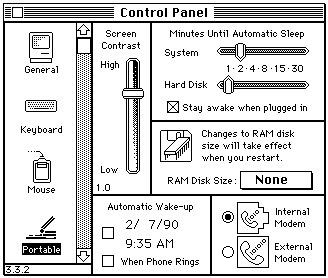
Figure 1: Virtual Devices in the Macintosh Control Panel
The figure shows graphical objects such as potentiometers,
radio buttons and icons. Each functions as a distinct device. Interaction,
however, is via one of two physical devices: the mouse or keyboard.
The strength of the illusion, however, speaks well for its effectiveness.
Nevertheless, this paper is rooted in a belief that direct manipulation
systems can be improved by expanding the design space to better afford turning
this illusion into reality. Distinct controls for specific functions, provide
the potential to improve the directness of the user's access (such as through
decreased homing time and exploiting motor memory). Input functions are
moved from the display to the work surface, thereby freeing up valuable
screen real-estate. Because they are dedicated, physical controls can be
specialized to a particular function, thereby providing the possibility
to improve the quality of the manipulation .
While one may agree with the general concepts being expressed, things generally
break down when we try to put these ideas into practice. Given the number
of different functions and virtual devices that are found in typical direct
manipulation systems, having a separate physical controller for each would
generally be unmanageable. Our desks (which are already crowded) would begin
to look like an aircraft cockpit or a percussionist's studio. Clearly, the
designer must be selective in what functions are assigned to dedicated controllers.
But even then, the practical management of the resources remains a problem.
The contribution of the current research is to describe a way in which this
approach to designing the control structures can be supported. To avoid
the explosion of input transducers, we introduce the notion of virtual input
devices that are spatially distinct. We do so by partitioning the surface
of one physical device into a number of separate regions, each of which
emulates the function of a separate controller. This is analogous on the
input side to windows on displays.
We highlight the properties that are required of the input technology to
support such windows, and discuss why certain types of touch tablets are
particularly suited for this type of interaction.
Finally, we discuss the functionality that would be required by a user interface
management system to support the approach. We do so by describing the implementation
of a working prototype system.
2. RELATIONSHIP TO PREVIOUS PRACTICE
The idea of virtual devices is not new. One of the most innovative approaches
was the virtual keyboard developed by Ken Knowlton (1975, 1977a,b) at Bell
Laboratories. Knowlton developed a system using half-silvered mirrors to
permit the functionality of keyboards to be dynamically reconfigured. Partitioning
a tablet surface into regions is also not new. Tablet mounted menus, as
seen in many CAD systems, are one example of existing practice.
Our contribution:
- makes this model explicit
- develops it beyond current common practice
- develops some of the design issues (such as input transducers)
- demonstrates its utility
- and presents a prototype User Interface Management (UIMS) utility to
support its use.
3. RELEVANT PROPERTIES OF INPUT TRANSDUCERS
The technique of "input windows" involves a mapping of different
functions to distinct physical locations in the control space. This mapping
can only be supported by input transducers that possess the following two
properties:
- Position Sensitive: They must give absolute coordinates defining
position, rather than a measure of motion (as with mice).
- Fixed Planar Coordinate System: Position must be measured in
terms of a two dimensional Cartesian space.
Hence digitizing tablets will work, but mice, trackballs, and joysticks
will not. Within the class of devices which meet these two criteria (including
light pens, graphics tablets, touch screens), touch technologies (and especially
touch tablets) have noteworthy potential.
Control systems that employ multiple input devices generally have two important
properties:
- Eyes-Free Operation: Sufficient kinesthetic feedback is provided
to permit the operation of the control, leaving the eyes free to perform
some other task, such as monitoring a display.
- Simultaneous Access: More than one device can be operated at
a time, as in driving a car (steering wheel and gear lever) or operating
an audio mixing console (where multiple faders might be accessed simultaneously).
In many design situations, these properties are useful, if not essential.
In mixing a colour in a paint program, one might assign a potentiometer
to each of hue, saturation and value. In performing the task, it is reasonable
to expect that the artist generally is better served by focusing visual
attention on the colour produced rather than the potentiometers controlling
its components values. Driving a car would be impossible if operating the
steering wheel required visual attention.
Simultaneous access is also important in many situations. Within the domain
of human-computer interaction, for example, Buxton and Myers (1986) demonstrate
benefits in tasks similar to those demanded in text editing and CAD.
4. THE AFFORDANCES OF TOUCH TABLETS
Touch tablets are interesting in that they can be designed and employed
in such a way as to afford eyes-free operation and simultaneous access.
As well, they can meet our constraints of providing absolute position information
in a planar coordinate system. In this, they are rare among input transducers.
The primary attribute of touch technologies that affords eyes-free operation
is their having no intermediate hand-held transducer (such as a stylus or
puck). Sensing is with the finger. Consequently, physical templates can
be placed over a touch tablet (as illustrated in Fig. 2) and provide the
same type of kinesthetic feedback that one obtains from the frets on a guitar
or the cracks between the keys of a piano. This was demonstrated in Buxton,
Hill and Rowley (1985). Because of the ability to memorize the position
of virtual devices and sense their boundaries, usage is very different than
that where a stylus is used, or where the virtual devices are delimited
on the tablet surface graphically, and cannot be felt.
An interesting result from our studies, however, is the degree to which
eyes-free control can be exercised on a touch tablet which is partitioned
into a number of virtual devices, but which has no graphical or physical
templates on the tablet surface.
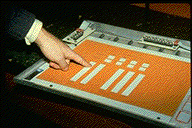
Figure 2: Using a template with a touch tablet
A cut-out template is being placed over a touch tablet. Each
cut-out represents a different virtual device on a prototype operating console.
The user can operate each device "eyes-free" since boundaries
of the virtual devices can be felt (due to the raised edges of the template).
If the tablet can sense more than one point of contact at a time, multiple
virtual devices can be operated at once. (From Buxton, Hill, & Rowley,
1985).
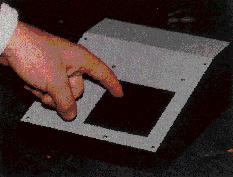
Figure 3: A 3"x3" Touch Tablet
A touch tablet of this size has the important property that
it is on the same spatial scale as the hand. Therefore, control and access
over its surface falls within the bounds of the relatively highly developed
fine motor skills of the fingers, even if the palm is resting in a fixed
(home?) position.
Using a 3"x3" touch sensitive touch tablet (shown in Fig. 3),
our informal experience suggests that with very little training users can
easily discriminate regions to a resolution of up to 1/3 of the tablet surface's
vertical or horizontal dimensions. Thus, one can implement three virtual
linear potentiometers by dividing the surface into three uniform sized rows
or columns, or, for example, one can implement nine virtual push-button
switches by partitioning the tablet surface into a 3x3 matrix.
If the surface is divided into smaller regions, such as a 4x4 grid, the
result will be significantly more errors, and longer learning time. In such
cases, using the virtual devices will require visual attention. The desired
eyes-free operability is lost.
These limits are illustrated in Fig. 4. For example, we see that nine buttons
for playing tick-tack-toe can work rather well, while a sixteen button numerical
button keypad does not. Similarly, three virtual linear faders to control
Hue, Saturation and Value work, while four such potentiometers do not.
Our belief is that the performance that we are observing is due to the size
of the tablet as it relates to the size of the hand, and the degree of fine
motor skills developed in the hand by virtue of everyday living. Being sensitive
to these limits is very important as we shall see later when we discuss
"dynamic windows." Because of this importance, these limits of
motor control warrant more formal study.1
(a ) (b)

(c) (d)

Figure 4: Grids on Touch Tablets
Four mappings of virtual devices are made onto a touch tablet.
In (a) and (c), the regions represent linear potentiometers. The surface
is partitioned into 3 and 4 regions, respectively. In (b) and (d) the surface
is partitioned into a matrix of push buttons (3x3 and 4x4, respectively).
Using a 3"x3" touch tablet without templates, our informal experience
is that users can resolve virtual devices relatively easily, eyes-free,
when the tablet is divided into up to 3 regions in either or both dimensions.
This is the situation illustrated in (a) and (b). However, resolving virtual
devices where the surface is more finely divided, as in (c) and (d), presents
considerably more load. Eyes-free operation requires far more training,
and errors are more frequent. The limits on this discrimination warrant
more formal study.
Finally, there is the issue of parallel access. Touch technologies have
the potential to support multiple virtual devices simultaneously. Again,
this is largely by virtue of their not demanding any hand-held intermediate
transducer. If, for example, I am holding a stylus in my hand, the affordances
of the device bias my expectations towards wanting to draw only one line
at a time. In contrast, if I were using finger paints, I would have no such
restrictive expectations.
A similar effect is at play in interacting with virtual devices implemented
on touch tablets. Consider the template shown in Fig. 2. Nothing biases
the user against operating more than one of the virtual linear potentiometers
at a time. In fact, experience in the everyday world of such potentiometers
would lead one to expect this to be allowed. Consequently, if it is not
allowed, the designer must pay particular attention to avoiding probable
errors that would result from this false expectation.
Being able to activate more than one virtual device at a time opens up a
new possibilities in control and prototyping. The mock up of instrument
control consoles is just one example. The biggest obstacle restricting the
exploitation of this potential is the lack of a touch tablet that is capable
of sensing multiple points. However, Lee, Buxton and Smith (1985) have demonstrated
a working prototype of such a transducer, and it is hoped that the applications
described in this current paper will help stimulate more activity in this
direction.
In summary, we have seen that position sensitive planar devices readily
support spatially distinct virtual input devices. Further, we have seen
that touch technologies, and touch tablets in particular, have affordances
which are particularly well suited to this type of interaction. Finally,
it has been shown that a touch tablet capable of sensing more than one point
of contact at a time would enable the simultaneous operation of multiple
virtual devices.
5. VIRTUAL INPUT TRANSDUCERS
In current "menu on the tablet" practice, there is typically just
one device driver which returns a single stream of coordinates. The application
must decode the data according to the current partitioning of the tablet.
This is all ad hoc, as are the means of specifying the boundaries of the
various partitions. There are few tools, and little flexibility.
In our approach, the data from each virtual device is transmitted to the
application as if it were coming from an independent physical device with
its own driver. If the region is a button device, its driver transmits state
changes. If it is a 1-D relative valuator, it transmits one dimension of
relative data in stream mode. All of this is accomplished by placing a "window
manager" between the device driver for the sensing transducer and the
application.2 Hence, applications can be constructed independent of how
the virtual devices are implemented, thereby maintaining all of the desired
properties of device independence. Furthermore, this is accomplished with
a uniform set of tools that allows one to define the various regions and
the operational behaviour of each region.
6. WHAT ABOUT DYNAMIC WINDOWS?
Window managers for displays can support the dynamic creation, manipulation,
and destruction of windows. Is it reasonable to consider comparable functionality
for input windows?
Our research (Buxton, Hill & Rowley, 1985) has demonstrated that under
certain circumstances, the mapping of virtual devices onto the tablet surface
can be dynamically altered. For example, in a paint system, the tablet may
be a 2D pointing device in one context, and in another (such as when mixing
colours) may have three linear potentiometers mapped onto it.
Changing the mapping of virtual devices onto the tablet surface restricts
or precludes the use of physical templates. However, this is not always
a problem. If visual (but not tactile) feedback is required, then a touch
sensitive flat panel display can provide graphical feedback as to the current
mapping. This is standard practice in many touch screen "soft machine"
systems.
As has already been discussed, under certain circumstances, some touch tablets
can be used effectively without physical or graphical templates. This can
be illustrated using a paint mixing example. Since there are three components
to colour, three linear potentiometers are used. As in Fig. 4(b), the potentiometers
are vertically oriented so that there is no confusion: up is increase, down
is decrease. The potentiometers are, left-to-right, Hue, Saturation, and
Value (H, S & V in the figure). This ordering is consistent with the
conventional order in speech, consequently there is little or no confusion
for the user.
The example illustrates three conditions for using virtual devices without
templates:
- a low number of devices;
- careful layout;
- strong compatibility between the virtual devices and the application.
Our objective is not to encourage or legitimize the arbitrary use of menus
on tablet surfaces. As many CAD systems illustrate, this often leads to
bad user interface design. What we hope we have done is identify a technique
which, when used in the appropriate context, will result in an improved
user interface.
7. UIMS's AND VIRTUAL DEVICES
User Interface Management Systems, or UIMS's, are sets of tools designed
to support iterative development of user interfaces through all phases of
development (Tanner & Buxton, 1983; Buxton, Lamb, Sherman & Smith,
1983). Ideally, this includes specification, design, implementation, testing,
evaluation and redesign. Typically, UIMS's provide tools for the layout
of graphic interfaces, control low level details of input and output, and
(more rarely) provide monitoring facilities to aid in evaluation of the
interfaces developed.
We have developed an input window manager (IWM). The tool consists
of a "meta device" that provides for quick specification of the
layout and behavior of the virtual devices. The specified configuration
functions independent of the application. Users employ a gesture-based
trainer to "show" the system the location and type of virtual
device being specified. Hence, for example, adding a new template involves
little more than tracing its outline on the control surface, defining the
virtual device types and ranges, and attaching them to application parameters.
Since the implementation of new devices can be achieved as quickly as they
can be laid out on the tablet, this tool provides a new dimension of system
tailorability.
In order to support iterative development, the tool should allow the user
to suspend the application program, change the input configuration (by invoking
a special process to control the virtual devices), and then proceed with
the application program using the altered input configuration.
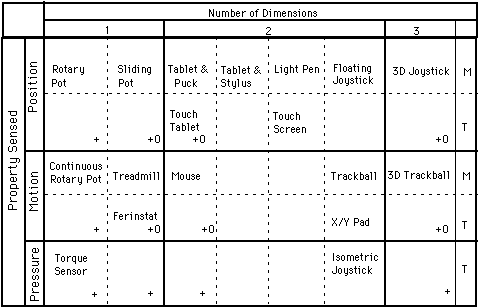
Figure 5. Taxonomy of Hand-Controlled Continuous Input Devices.
Cells represent input transducers with particular properties.
Primary rows (solid lines) categorize property sensed (position, motion
or pressure). Primary columns categorize number of dimensions transduced.
Secondary rows (dashed lines) differentiate devices using a hand-held intermediate
transducer (such as a puck or stylus) from those that respond directly to
touch - the mediated (M) and touch (T) rows, respectively. Secondary columns
group devices roughly by muscle groups employed, or the type of motor control
used to operate the device. Cells marked with a "+" can be easily
be emulated using virtual devices on a multi-touch tablet. Cells marked
with a "O" indicate devices that have been emulated using a conventional
digitizing tablet. After Buxton (1983).
8. THE REPERTOIRE OF SUPPORTED VIRTUAL DEVICES
The impact of the physical device used on the quality of interaction has
been discussed by Buxton (1983). The objective, therefore, is to make available
as broad a repertoire of "virtual" devices as possible from a
limited number of physical transducers. We based our initial prototype on
a conventional graphics tablet, and have designed to include future support
for both single and multiple touch-sensitive tablets. The repertoire of
virtual devices supported by our prototype is indicated in Fig 5.
9. A PROTOTYPE INPUT WINDOW MANAGER
The architecture of the IWM that we have implemented is depicted in Figure
6. The user interacts with the IWM at two separate points indicated by ovals
in the diagram. The Trainer program, provides for configuring the
input control structure. The application exists outside of the IWM,
and the workings of the IWM are incidental to it (other than the interface
to the request handler).
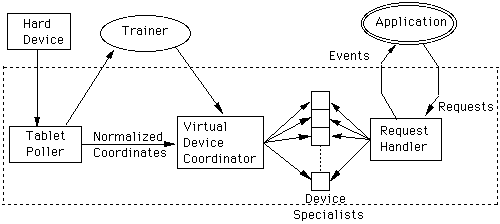
Figure 6. Architecture of a Prototype Input Window Manager
The tablet poller monitors the activity on the physical device,
filters redundant information, and normalizes the data points before passing
them on. The normalized format allows use of a range of physical devices
simply by changing the tablet poller for the specific device.
The virtual device coordinator is active if the current activity
is not a trainer session. It uses the incoming tablet data and the configuration
provided by a trainer session to identify the virtual device to which the
incoming data belongs. It passes the appropriate information on to the device
specialist (device driver) for that virtual device. The device specialist
determines the effect of the input and signals the request handler
appropriately.
The virtual devices are accessed by the application program through two
communication routines. One routine allows the activation and deactivation
of various types of event signals. The other routine accesses the event-queue,
returning the specifics of the last event to be signaled. A number of requests
are available to the activation routine, including discrete status checks
on a device, turning the device "on" or "off" for continuous
event signaling, and a utility shutdown request.
The request handler module interprets and acts on requests from the application
program, altering or extracting information of the device specialists as
needed. It posts appropriate events to the event queue.
Finally, the architecture is such that much of the underlying software can
reside in a dedicated processor, thereby freeing up resources on the machine
running the main application. This includes the part of the tablet poller,
the internal representation of the current mapping of the virtual devices
onto the tablet, and the virtual device coordinator.
10. CONCLUSION
This paper has discussed one way of making direct manipulation interfaces
more direct and manipulation more effective. The general approach has been
to extend the number of discrete and continuous controllers which can be
tied to different functions. This is accomplished through spatially distinct
virtual devices, and an input window management system. In the process,
a number of properties of input devices have been discussed, and a prototype
system presented. The results have important implications on the usability
and tailorability of systems, and the architecture of UIMS's.
The work described has been exploratory. Nevertheless, we feel that the
results are sufficiently compelling to suggest that more formal investigations
of the issues discussed are warranted. We hope that the current work will
help serve as a catalyst to such research.
ACKNOWLEDGEMENTS
The work described in this paper has been supported by the Natural Science
and Engineering Research Council of Canada and Xerox PARC. This support
is gratefully acknowledged. We would also like to acknowledge the contribution
of Ralph Hill, Peter Rowley and Abigail Sellen. Finally, we would like to
thank Tom Milligan for his help in proof-reading the final manuscript.
NOTES
1 It must be emphasized that the limits discussed here were obtained through
informal study. We intend only to suggest that there is something interesting
and useful here, rather than to imply that these are experimentally derived
data.
2 We thank Alain Fournier for first suggesting the analogy with window managers.
REFERENCES
Anson, E. (1982). The Device Model of Interaction. Computer Graphics, (16,3),
107-114.
Buxton, W. (1983). Lexical and Pragmatic Considerations of Input Structures.
Computer Graphics, (17,1), 31-37
Buxton W., Hill R., & Rowley P. (1985). Issues and Techniques in Touch-Sensitive
Tablet Input. Computer Graphics, 19(3), 215 - 224.
Buxton, W., Lamb, M., Sherman, D., & Smith, K.C. (1982). Towards a Comprehensive
User Interface Management System. Computer Graphics, (16,3), 99-106.
Buxton, W. & Myers, B. (1986). A Study in Two-Handed Input. Proceedings
of CHI'86 Conference on Human Factors in Computing Systems, 321-326.
Evans, K. Tanner, P., & Wein, M. (1981). Tablet-based Valuators that
Provide One, Two, or Three Degrees of Freedom. Computer Graphics (15,3),
91-97.
Kasik, D. (1982). A User Interface Management System. Computer Graphics,
(16,3), 99-106.
Knowlton, K. (1975). Virtual Pushbuttons as a Means of Person- Machine Interaction.
Proc. IEEE Conf. on Computer Graphics, Pattern Matching, and Data Structure.,
350-351.
Knowlton, K. (1977a). Computer Displays Optically Superimposed on Input
Devices. The Bell System Technical Journal (56,3), 367-383.
Knowlton, K. (1977b). Prototype for a Flexible Telephone Operator's Console
Using Computer Graphics. 16mm film, Bell Labs, Murray Hill, NJ.
Lee S., Buxton, W., & Smith, K.C. (1985). A Multi-Touch Three Dimensional
Touch Tablet. Proceedings of CHI'85 Conference on Human Factors in Computing
Systems, 21 - 25.
Myers, B. (1984a), Strategies for Creating an Easy to Use Window Manager
with Icons. Proceedings of Graphics Interface '84, Ottawa, May, 1984, 227
- 233.
Myers, B. (1984b), The User Interface for Sapphire. IEEE Computer Graphics
and Applications, 4 (12), 13 - 23.
Pike, R. (1983). Graphics in Overlapping Bitmap Layers. Computer Graphics,
17 (3), 331 - 356.
Tanner, P.P. & Buxton, W. (1985). Some Issues in Future User Interface
Management System (UIMS) Development. In Pfaff, G. (Ed.), User Interface
Management Systems, Berlin: Springer Verlag, 67 - 79.







